Ptolemy and non-Archimedes
Gavin Wraith
If you have any four numbers A,B,C and D, elementary algebra will tell you that
![]()
Claudius Ptolemy (2nd Century AD) proved in the Almagest that four points A,B,C and D lie on a circle if and only if the distances between them satisfy the equation
![]()
a formula of striking similarity, which is traditionally phrased as saying
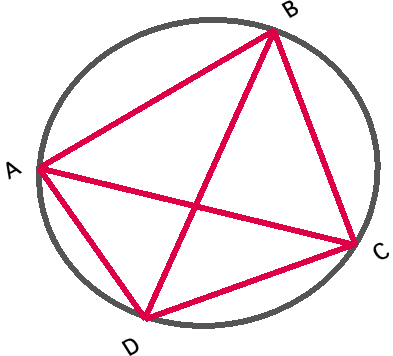
a quadrilateral is cyclic (can be inscribed in a circle ) just when the product of the lengths of the diagonals equals the sum of the products of the lengths of opposite sides.
Suppose we have any four points A,B,C and D, not necessarily lying on a circle, in some sort of flow - continuous flow lines that only cross the straight lines AB,BC,CD,AD,AC and BD once, with no doubling back. Here is a typical diagram to show what I mean:
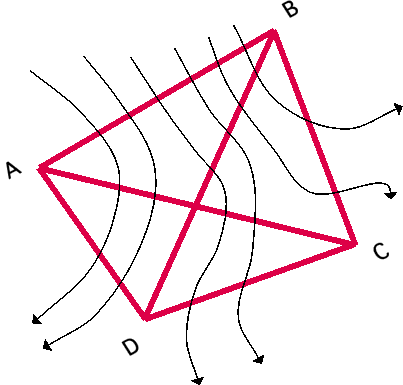
Let us write [ X,Y ] for the number of flow lines crossing the line XY. In this case we see that
![]()
![]()
These satisfy the formula
![]()
and a little bit of thought about the different possible configurations will convince you that this is always the case. We have a combinatorial fact: The total number of crossings on the diagonals is the maximum of the total number of crossings for each pair of opposite sides.
Mathematics is not just about calculation. It is about explaining patterns. I think you will agree that Eq1, Eq2 and Eq3 have much the same pattern, so what are the connections between the three formulae?
Let us look at the differences first. In Eq1 A,B,C and D stand for numbers, whereas in the other two they stand for points in a plane. If we look closer, we see that in Eq1 we only use differences of two numbers and in Eq2 and Eq3 we only use the line segment between two points. That is surely a sort of difference. In Eq1 and Eq2 we first combine numbers by multiplying, and on the right hand side we combine again by adding, whereas in Eq3 we first combine with addition and then combine using maximum. So the change from Eq1/Eq2 to Eq3 can be expressed
![]()
The connection between Eq1 and Eq2 can be explained with complex numbers and the connection between Eq2 and Eq3 by using a weird notion of distance - a non-Archimedean metric.
Complex numbers
Just as we represent real numbers as points on a line with a special point chosen to represent zero, so we can represent complex numbers as points in a plane, with a special point to represent zero (the origin) and a special line through it (the real axis) to represent real numbers.
If we write |A| to denote the magnitude of a real number A (i.e. we forget about the sign of A) then |A - B| is the distance between A and B. This notation can be extended to complex numbers, so that if z is a complex number |z| denotes the distance between z and zero. We write Arg(z) for the angle between the positive real axis and the line from zero to z.
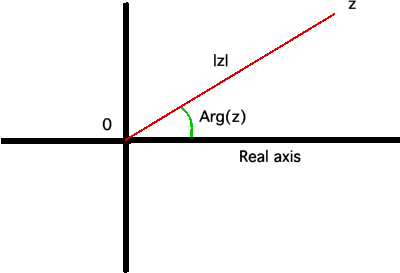
The complex number z is determined completely by its distance |z| from the origin and by the angle Arg(z) which indicates the direction in which you must travel from the origin to reach it. Addition of complex numbers is just vector addition: add the horizontal displacements, add the vertical displacements.
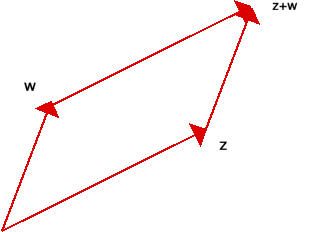
Multiplication of complex numbers satisfies the rules
![]()
The distance between points A and B, conceived as complex numbers, is |A - B|. So if A,B,C and D lie on a circle Ptolemy's theorem says that
![]()
Now from Eq1 we certainly have
![]()
but the right hand side is not quite what we want. So when is it true that |X+Y| is the same as |X| + |Y| ? The answer is: when Arg(X) = Arg(Y). If the line from zero to X and the line from zero to Y point in the same direction then vector addition becomes the same thing as addition of distances. Now we must use the fact that A,B,C and D lie on a circle. We will take zero to be the centre of the circle. We note the fact that if P and Q lie on the circle then
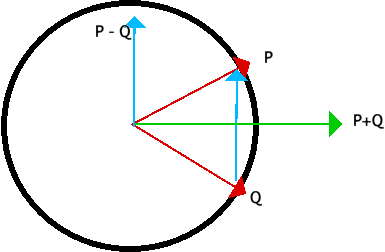
P - Q points at right angles to P + Q and clearly Arg(P + Q) is the average of Arg(P) and Arg(Q). So we conclude that
![]()
So we get that
![]()
![]()
![]()
and in consequence
![]()
![]()
So Eq2 follows from Eq1.
Aside for aficionados of projective geometry: the condition that
![]()
is equivalent to the condition that the lines from the circular points at infinity to A,B,C and D have the same cross-ratio, from which it follows that A,B,C,D lie on a circle.
The notion of distance
The absolute value function, that gives us our idea of distance, has the following properties:
![]()
![]()
![]()
![]()
Are there any other functions that have these properties? If we restrict ourselves to complex numbers whose coordinates (real and imaginary parts) are fractions of whole numbers, then yes there are. Choose, for example, a prime number p whose remainder for division by 4 is 3. Then any of our complex numbers, apart from zero, can be written uniquely in the form
![]()
where n is an integer and w is a complex number whose coordinates, written as fractions in their lowest terms, have no factor of p in either numerator or denominator. If we define N by the rule
![]()
then we find that the rules above hold, when we write N(x) instead of |x|. So N defines a new sort of distance, which behaves rather oddly compared to our usual notion. The more factors of p a number has, the smaller it is. We find that
![]()
for all notions of distance, except our usual one. This condition is a strengthening of the triangle inequality, that says that going round two sides of a triangle cannot be shorter than going along one side. Geometry with this sort of notion of distance is called non-Archimedean.
All triangles are isosceles in such geometries. Take one of the vertices of the triangle to be zero, and the other two to be X and Y. If N(X) is not equal to N(Y), then suppose without loss of generality that N(X) < N(Y). Then
![]()
![]()
so the side from Y to X has the same length as the side from zero to X.
More to the point, any four points lie on a circle! For if we take zero to be the average of four points A,B,C and D we have A+B+C+D = 0, whence
![]()
from which we deduce that N(A) = N(B) = N(C) = N(D), so they all lie on a circle with centre zero.
So the Archimean distance satisfies the same formula as the number of flow lines.